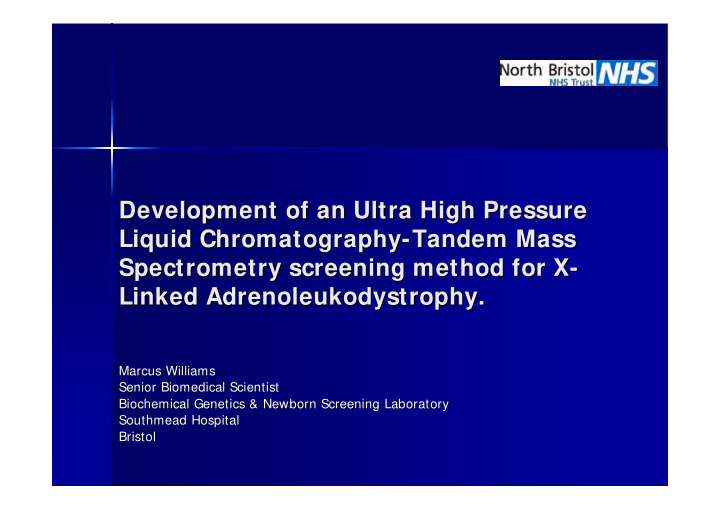



Development of an Ultra High Pressure Development of an Ultra High Pressure Liquid Chromatography- -Tandem Mass Tandem Mass Liquid Chromatography Spectrometry screening method for X- - Spectrometry screening method for X Linked Adrenoleukodystrophy. Linked Adrenoleukodystrophy. Marcus Williams Marcus Williams Senior Biomedical Scientist Senior Biomedical Scientist Biochemical Genetics & Newborn Screening Laboratory Biochemical Genetics & Newborn Screening Laboratory Southmead Hospital Southmead Hospital Bristol Bristol
I ntroduction I ntroduction n X X- -ALD ALD n – Most common of the Most common of the peroxisomal peroxisomal disorders affecting disorders affecting – somewhere in the region of 1:17000 individuals. somewhere in the region of 1:17000 individuals. n Affects the nervous system, adrenal cortex and Affects the nervous system, adrenal cortex and n testis. testis. n Wide Phenotypic variation Wide Phenotypic variation n n BMT most affective intervention in severe forms BMT most affective intervention in severe forms n n Narrow therapeutic window Narrow therapeutic window n n Current diagnosis is by plasma VLCFA analysis and Current diagnosis is by plasma VLCFA analysis and n confirmed by DNA mutation analysis. confirmed by DNA mutation analysis. n Newborn screening would greatly improve Newborn screening would greatly improve n prognosis prognosis
Project aims Project aims Look at C26:0 lysophosphatidylcholine lysophosphatidylcholine Look at C26:0 1. 1. (C26:0- -lyso lyso- -pc) as a marker for X pc) as a marker for X- -ALD ALD (C26:0 in newborn screening bloodspots in newborn screening bloodspots Optimise MS conditions Optimise MS conditions 2. 2. Optimise LC conditions Optimise LC conditions 3. 3. Validate method Validate method 4. 4.
MS parameters MS parameters Expected fragmentation of lyso pc’s I nitial MRM transitions C26:0-lyso-pc 636 > 104 636 > 184 C26:0-lyso-pc D4 640 > 104 640 > 184
Chromatography 06031102 MRM of 4 Channels ES+ 3.60 TIC 100 2.63e5 3.40 % 0 Time 0.50 1.00 1.50 2.00 2.50 3.00 3.50 4.00 4.50 5.00 5.50
I nternal Standard 13031103 Sm (SG, 2x5) MRM of 4 Channels ES+ 2.77 TIC 100 2.66e4 2.63 % 0 0.20 0.40 0.60 0.80 1.00 1.20 1.40 1.60 1.80 2.00 2.20 2.40 2.60 2.80 3.00 3.20 3.40 3.60 3.80 13031103 Sm (SG, 2x5) MRM of 4 Channels ES+ 2.77 640 > 104 (C26 IS) 100 1.15e4 % 0 0.20 0.40 0.60 0.80 1.00 1.20 1.40 1.60 1.80 2.00 2.20 2.40 2.60 2.80 3.00 3.20 3.40 3.60 3.80 13031103 Sm (SG, 2x5) MRM of 4 Channels ES+ 2.76 640 > 184 (C26 IS) 100 2.63 1.50e4 % 0 Time 0.20 0.40 0.60 0.80 1.00 1.20 1.40 1.60 1.80 2.00 2.20 2.40 2.60 2.80 3.00 3.20 3.40 3.60 3.80
Standard STD 13031102 Sm (SG, 2x5) MRM of 4 Channels ES+ 636>104 2.79 636 > 104 (C26) 100 2.21e4 % 0 0.50 1.00 1.50 2.00 2.50 3.00 3.50 13031102 Sm (SG, 2x5) MRM of 4 Channels ES+ 636>184 2.79 636 > 184 (C26) 100 2.47e4 % 2.64 0 0.50 1.00 1.50 2.00 2.50 3.00 3.50 TIC 13031102 Sm (SG, 2x5) MRM of 4 Channels ES+ 2.79 TIC 100 4.70e4 % 2.64 0 Time 0.50 1.00 1.50 2.00 2.50 3.00 3.50
Standard curve 8 7 6 C26:0-lyso-pc response ratio 5 4 3 2 1 0 0 200 400 600 800 1000 1200 1400 1600 1800 C26:0-lyso-pc Standard concentration (nmol/L) The Standard curve for C26:0-lyso-pc up to 1560 nmol/L (n= 11) Pearson’s correlation coefficient, r= 0.999986
Recovery experiment 0.25 0.2 C26:0-lyso-pc response ratio n=12 0.15 0.1 0.05 0 0 500 1000 1500 2000 2500 3000 3500 C26:0-lyso-pc spiked sample concentraion (nmol/L) The mean response of each of the 11 spiked samples (r= 0.99700325)
Limit of detection Limit of detection experiment experiment Sample C26:0-lyso-pc Signal / noise ratio concentration (pmol/ L) 1 49000 349.3 2 24500 172.1 3 12000 99.5 4 6000 74.1 5 3000 27.0 6 1500 16.6 7 765 12.9 8 383 9.9 9 191 6.2 10 96 3.9
Summary Summary n C26:0 C26:0- -lyso lyso- -pc is a putative marker for X pc is a putative marker for X- - n ALD ALD n UPLC UPLC- -MS/MS method MS/MS method is suitable is suitable for high for high n throughput screening throughput screening n ‘ ‘Dilute and shoot Dilute and shoot’ ’ bloodspot extraction bloodspot extraction n procedure procedure n Analysis time of 3.5 minutes Analysis time of 3.5 minutes n n Further work to include establishing a Further work to include establishing a n reference range in neonates reference range in neonates
Recommend
More recommend